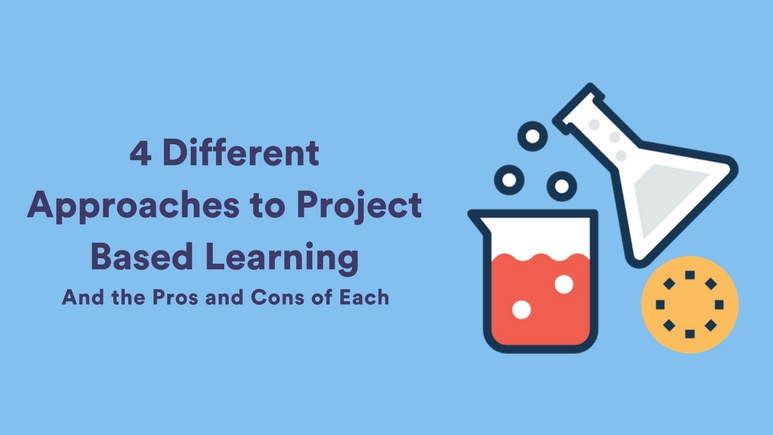
There’s no doubt that “project-based learning” is something of a buzzword in education right now.
Teachers of all subjects and grades are finding ways to engage students in meaningful and open-ended learning tasks.
But a closer look reveals that a huge spectrum of activities fit the criteria for “project-based learning”.
From hour-long science experiments to semester-long research projects, inquiry-based learning experiences are certainly diverse.
In fact, if you look closely at these different types of projects, you’ll find that there are four commonly accepted ways to structure project-based learning (PBL).
Each of these approaches has it’s own pros and cons. In this quick read, you can learn the basics of these four modes of learning to help choose which is best the best fit for your current students.
Structured Projects
If you were to look at project-based learning as a swimming pool, structured learning experiences represent the shallow end.
In a structured inquiry, the teacher still holds the reins, and the entire class participates in inquiry together.
While this might not sound like students have much autonomy in the process, structured inquiry experiences can be very powerful for students who have never engaged in this sort of learning before.
A common example of structured inquiry experience are traditional science experiments.
The teacher poses the question (what effect does gravity have on plant growth?), provides the materials (seeds, soil, water, etc.), and insists on answering specific questions or collecting data in a particular way (data tables, graphs, a traditional lab report).
In the process, students learn how to ask questions, make observations, and draw conclusions in an inquiry-based setting.
Pros: less room for mistakes, can be done in a shorter time frame, easier to grade
Cons: lack of autonomy for students
Controlled Projects
Wading a little deeper into the inquiry pool leads us to controlled projects.
In a controlled learning environment, the teacher selects the topic and resources that students will use, but the essential questions are numerous and students can explore them more freely.
For example, a teacher might ask students to analyze the effects of Jim Crow laws on society in the United States and then compare this to Apartheid in South Africa.
Students would be provided with primary sources, photos, and statistical information to investigate and draw conclusions from.
In this learning environment teachers provide the questions, resources, and final outcome, but the means for getting to said outcome is up to students.
Pros: great for group projects, easier to grade
Cons: all students are still studying the same topic, little room for student interests
Guided Projects
In the gradual release of autonomy to students, guided inquiry is the next step.
In this setting, the teacher will choose a topic and provide questions, but students determine what resources they’ll use to answer the question and how they’ll demonstrate learning.
Guided inquiry is always interesting because, at the end of a lesson or unit, students will have different understandings and presentations of the same topic, and can then deepen learning by sharing findings with one another.
For example, in an English class students might investigate the power of bias in the media.
From there, though, students can focus on different topics, time periods, or types of media.
Students might compile their findings into an essay, a powerpoint presentation, a video, or a poster presentation to be shared with the rest of the class.
Pros: students choose topics, great for sharing
Cons: requires clear grading criteria that can fit different learning outcomes
Free Inquiry Projects
Finally, students take a dive into the deep end of PBL with free inquiry learning.
Here, students choose their topics, essential questions, resources, and final outcome.
Free inquiry assignments are a popular option as a capstone project for a class or unit.
As such, students choose a theme or topic that interests them and set up their own plan for how they’ll proceed from there.
Just because students are taking the reins here, doesn’t mean that there’s no role for the teacher.
In free inquiry projects, the teacher should act as a coach. Conference with students, ask them to justify their choice of resources, and provide moral support where necessary.
Free inquiry can be scary and intimidating for students, but the learning payoffs are huge!
Pros: complete student autonomy, powerful way to learn soft skills along with content
Cons: can be very time intensive, requires more teacher planning up front
Where to Start with Project Based Learning
Just as you wouldn’t throw a child who’s never been in a pool directly into the deep end, teachers should be careful about launching straight into free inquiry.
Depending on your students, you don’t necessarily need to progress through each of these types of project-based learning, but it’s a good idea to be thoughtful about where you start.
At the end of the day, free inquiry projects provide the biggest payoff in making students the masters of their own learning and developing 21st-century skills.
With a little practice, all students can benefit from being able to choose what they learn, how they learn it, and in what way they’ll demonstrate their learning.
Just be ready to act as a supportive coach along the way!



Leave a Reply